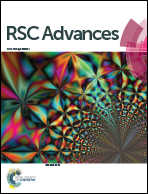Rheological behavior of hydrophobically modified polysulfobetaine methacrylate aqueous solution
Abstract
Polysulfobetaine methacrylate (PSBMA) that was hydrophobically modified with methacrylic acid 2,3-epoxypropyl ester (GMA) was synthesized via the micellar copolymerization method. Basic properties of the obtained copolymer were investigated via fluorescence, transmission electron microscopy (TEM), dynamic light scattering (DLS), zeta-potential analyzer, etc. The rheological properties of polymer (or copolymer) solutions were determined as a function of shear rate, temperature, NaCl concentration, etc. Hydrophobically modified PSBMA were capable of forming micelles even at extremely low concentrations (0.001 g L−1), and the micelle sizes increased upon increasing concentration. Hydrophobic interactions were observed within the system and were enhanced with increasing copolymer concentration. Both PSBMA with and without hydrophobic modification exhibited negative zeta-potential and increased with increasing polymer concentration. The viscosity of the P(SBMA–GMA) aqueous solution showed features that are different from those of typical polymer solutions. In addition, the rheological behavior of hydrophobically modified PSBMA aqueous solution had an unusual relationship with temperature because of hydrophobic association and epoxy groups. The viscosity of hydrophobically modified PSBMA solution was sensitive to the added salt concentration, i.e., the viscosity initially decreased and subsequently increased upon the addition of salt.


 Please wait while we load your content...
Please wait while we load your content...